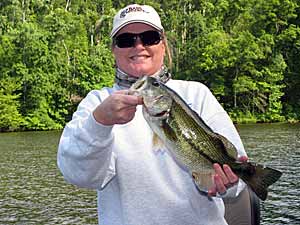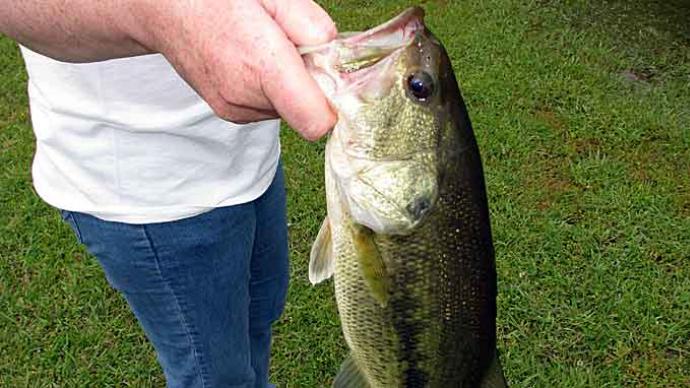
I am an avid bank fisherman. You'll find me fishing ponds near my house almost every day. As I increasingly fish from the bank, I've learned much about approaching a pond. But, despite your thoughts, there are better and worse ways to fish from the bank.
One of the common worse methods I see utilized often is when bank fishermen aren't picky about where they cast. Instead, they stand in their favorite spot, randomly lobbing cast after cast as far as possible to the pond's middle. Can you catch fish like that? Yes. Is it the best way to catch fish? No.
Let me share how I've learned to fish a spot from the bank.
-
Approach in a stealthy manner: I've observed that when I walk right up to my spot, stand right next to the water's edge, and make a cast, there are often swirls in the water as a bass, startled by my presence, seeks safety in deeper water. I've learned to walk stealthily about 5-7 feet up to the water and quietly flip a Senko or a worm into the shallows. I'll often get a fish or at least a bite five feet from shore.
Bank fishing also necessitates that you leave bright-colored clothing at home. I like black, grey/green, camouflage, or sky-colored blue clothing. These colors help me blend in with my surroundings and appear less evident to a fish. If fishing from a dock, I flip around and skip under the dock before quietly walking onto it. One of my pet peeves is when people tread heavily on a dock. Do they think that the fish aren't spooked when they do that? To many people, this approach may seem like an overdose, and truthfully, I don't always follow it 100 percent of the time. However, it will catch bass.
-
Pick off cover: before doing anything else: I like to work visible, isolated cover. Logs, sticks, plants, and rocks are all fair game here. A worm slowly worked alongside cover usually does the trick. A bass often sits under a log or waits under lily pads to ambush unsuspecting prey. In these cases, a tantalizing worm bouncing off the bottom or shimmying down the water column is hard to resist. Be quiet in your presentation. I usually prefer to flip or pitch a worm. Remember, one cast is not enough. I like to make at least a cast to the right side of the cover and the left if not more.
-
Fan-cast the area: After pitching to isolated cover, I finally started making long casts using fan-casting. If you're not familiar with it, this involves throwing to the entirety of your spot, working from left to right in a half-circle pattern not unlike an oriental fan. It's not limited to bank fishing, but it is, in my opinion, best visualized from the bank. You start to the far right or the far left of your spot, casting your lure as far and as parallel to the bank as you can. After retrieving it, you cast about a half-a-foot interval out from your original cast, keeping it up until you've made as even of a half-circle with your casts as you can make it.
Why is fan casting important? It helps you to be thorough in the coverage of your area. You can find cover under the water that you may not have known was there before. You may never have caught a bass parallel to the bank before. Fan-casting helped to show me that bass often hang out within inches of the shore. If you are unfamiliar with the idea, give it a try. It consistently produces results.
-
Work with the clues you've gained: Once you've completed all the above steps with your spot, think through the clues you've discovered about this particular spot. For example, did you have any bites? If so, where did they come from? Did a fish bite after you hit a log with your bait? If so, target logs.
Do you need to fan cast the spot again, at a slower speed or different depth? Do you need to switch up baits? Do you need to move to another spot? I typically move spots after fan-casting with a slower-moving bait, such as a worm, but with a topwater or a reaction bait, I like to play around with my retrieve. So I'll try fan-casting the area once while reeling or working the bait slowly, once while moving my bait at a medium speed, and once while burning the bait.
Whatever you choose to do after fan-casting your spot once, keep it up until you get a bite at a certain retrieve, then key in on and duplicate that presentation.
I've told you what works for me; now, see what works for you! Try being deliberate about the area you fish. I promise you will catch more fish.




